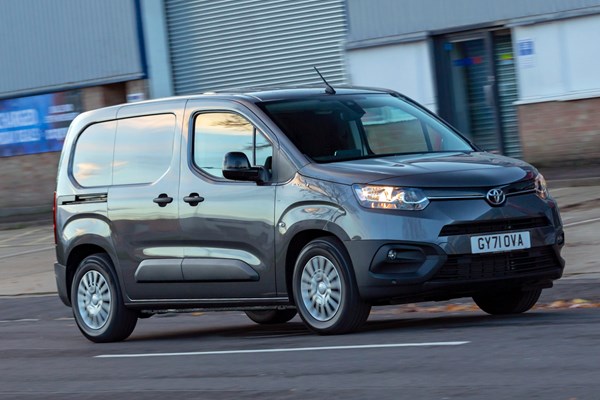Toyota Proace City Electric van review (2023)
Superb small electric van with up to 10 years of warranty cover
PROS
- Excellent electric drivetrain
- Good payload for electric van
- Quiet and comfortable
- Keen value
- 10-year warranty
CONS
- Driving range still restrictive
- Single trim level
- Not much safety kit
- Not much security kit
- Same as three other vans
Summary
Let’s not beat around the bush – if you want the best small electric van right now then look no further than the Toyota Proace City Electric. This review will explain the reasons why, but also talk you through the limitations, which remain an important consideration for any electric van.
If you’ve been looking at electric vans seriously, you’ll already know that the Proace City Electric is one of five basically identical vans – the other four being the Citroen e-Berlingo, Fiat E-Doblo, Peugeot e-Partner and Vauxhall Combo Electric, which are all part of the Stellantis family.
The standard diesel Toyota Proace City is the 2023 Parkers Small Van of The Year. Stellantis builds both versions for Toyota.
What makes the Toyota Proace City Electric the best choice?
Any of these models is a good choice for a small e-van, for as far as the important technical bits go – the electric motor and the battery pack – all four of them are identical. The Toyota still stands out because you can have up to 10 years of warranty cover at no extra charge. The Toyota Professional dealer network available to support van customers is also growing and impressive.

Basic specification is a little lower than those other vans, so if you want a fancy all-digital instrument cluster and a choice of trim levels, you’ll need to look beyond Toyota. But if you just want a well-priced example of leading electric van technology, the Proace City is where you should start.
What’s the driving range of the Proace City Electric?
The official WLTP driving range for the Proace City Electric is 168 miles per charge. In reality whether you’ll get close to that figure will depend on where and how you drive, how much you’re carrying in the back – and even the time of year.
There’s more on this in the Driving section below.
How long does it take to charge the Proace City Electric?
These vans are sold with a single battery pack size of 50kWh. The charging time depends on the power of the charging system.
Using a powerful DC public charger, you can get an 80% charge in as little as 30 minutes.
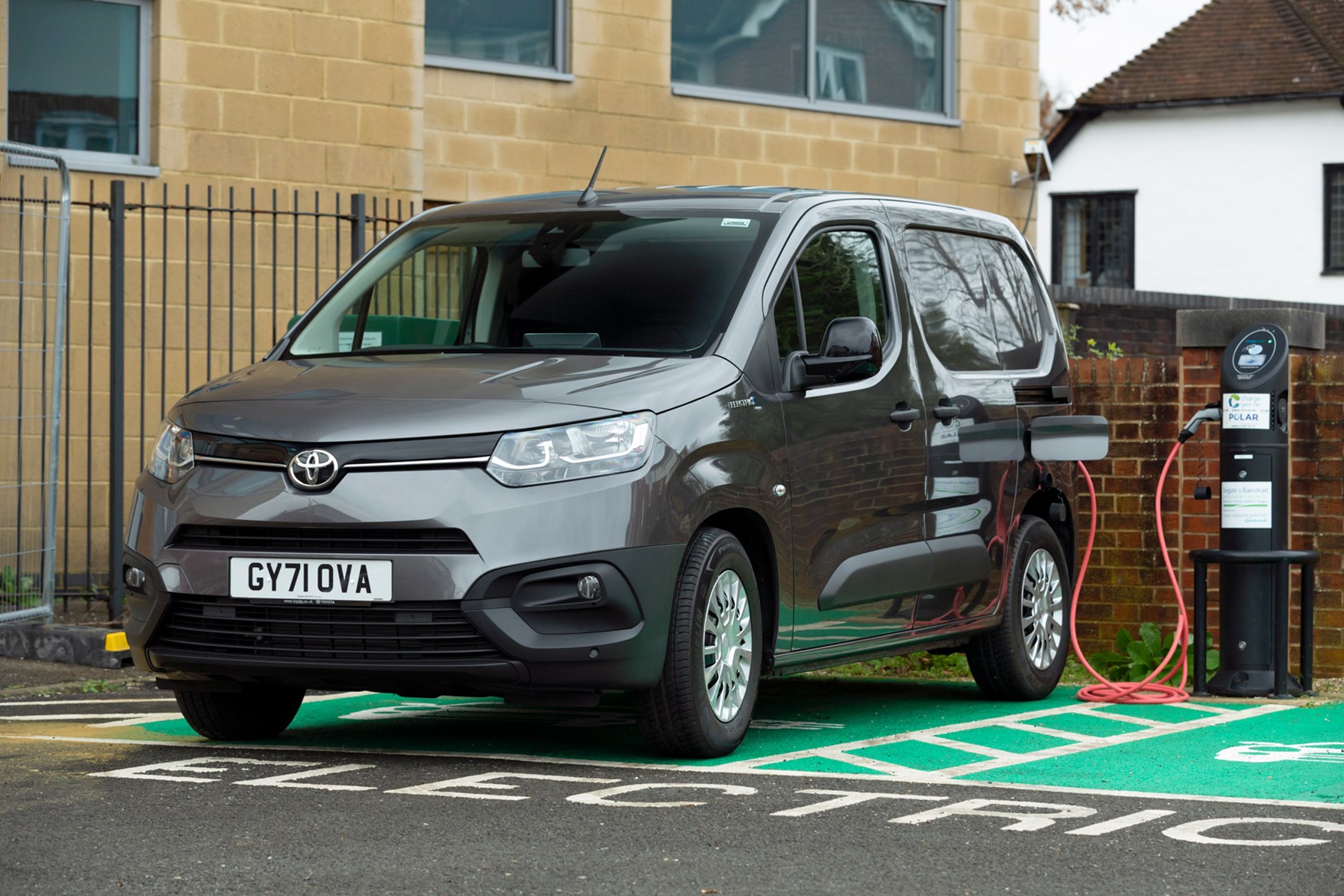
A conventional 7kW Wallbox AC charger (the kind of thing you might have at home) will need 7.1 hours for a full charge; the more powerful 11kW Wallbox type will do the same in 4.5 hours – there is a small cost to make the van compatible with these as well.
A regular domestic three-pin plug will need 30.5 hours.
How many different versions are there?
Toyota’s strategy with electric vans is cautious – it offers just one trim level (Icon) and a choice of two body lengths. Standard equipment is fine, and covered in detail in the Costs section of this review.
Maximum payload is highly competitive with most other conventional small vans, though it isn’t as great as the diesel version of the Proace City and its relations can manage. Full details of this can be found on our dedicated Toyota Proace City Electric dimensions page.
Are there any other rivals?
The small electric van market has long been dominated by the Renault Kangoo ZE – now called the Kangoo E-Tech – and the Nissan e-NV200. Both of these are ancient now, however, and will be replaced by brand new models in 2023.
Like the Stellantis quadruplets, the new Kangoo E-Tech and electric Nissan Townstar are the same van beneath the branding; there will also be a Mercedes-Benz eCitan based on this platform in 2023 as well.
There are no other serious small electric vans on the horizon, although some Chinese firms are showing increasing interest in the UK. But worth considering for similar money is the Maxus e Deliver 3, which offers impressive real-world electric capability in a slightly larger (if also quirky) package.
>> The best electric vans you can buy now
Verdict: should I buy a Toyota Proace City Electric
Keep reading this review for full details, but the short answer is, yes, if you want a small electric van, you should probably buy a Toyota Proace City Electric. The firm has a serious light commercial vehicle dealer network in the UK, an excellent reputation for customer service and a warranty package that’s unmatched. And the van is based on the best tech currently available.
We’ll revisit this verdict in 2023, once we’re driven incoming rivals from Renault, Mercedes and Nissan, but for now this is certainly our top choice.
Skip to our full verdict on...
- Smooth, quiet and comfortable to drive
- Plenty of performance and a choice of driving modes
- Real-world range may not make it suitable for everyone
The Proace City Electric has twin advantages when it comes to the driving experience. Generally speaking, electric vans are always nicer to drive than their petrol and diesel counterparts, and the Proace City is already based on one of the nicest driving small van platforms on the road.
Power and performance
The electric version of the Proace City is powered by a 100kW electric motor, turning the front wheels via a single speed transmission. It’s like driving the smoothest automatic you can imagine.
That 100kW figure is equivalent to 136hp and 260Nm of torque, but you only get that full whack if you select the Power driving mode. The van will always start in the Normal setting, which gives you 80kW of power – equivalent to 110hp and 210Nm.
If you really need to maximise your driving range, there’s an Eco setting, which drops output to 60kW / 82hp / 180Nm and cuts the heating to reduce energy consumption.
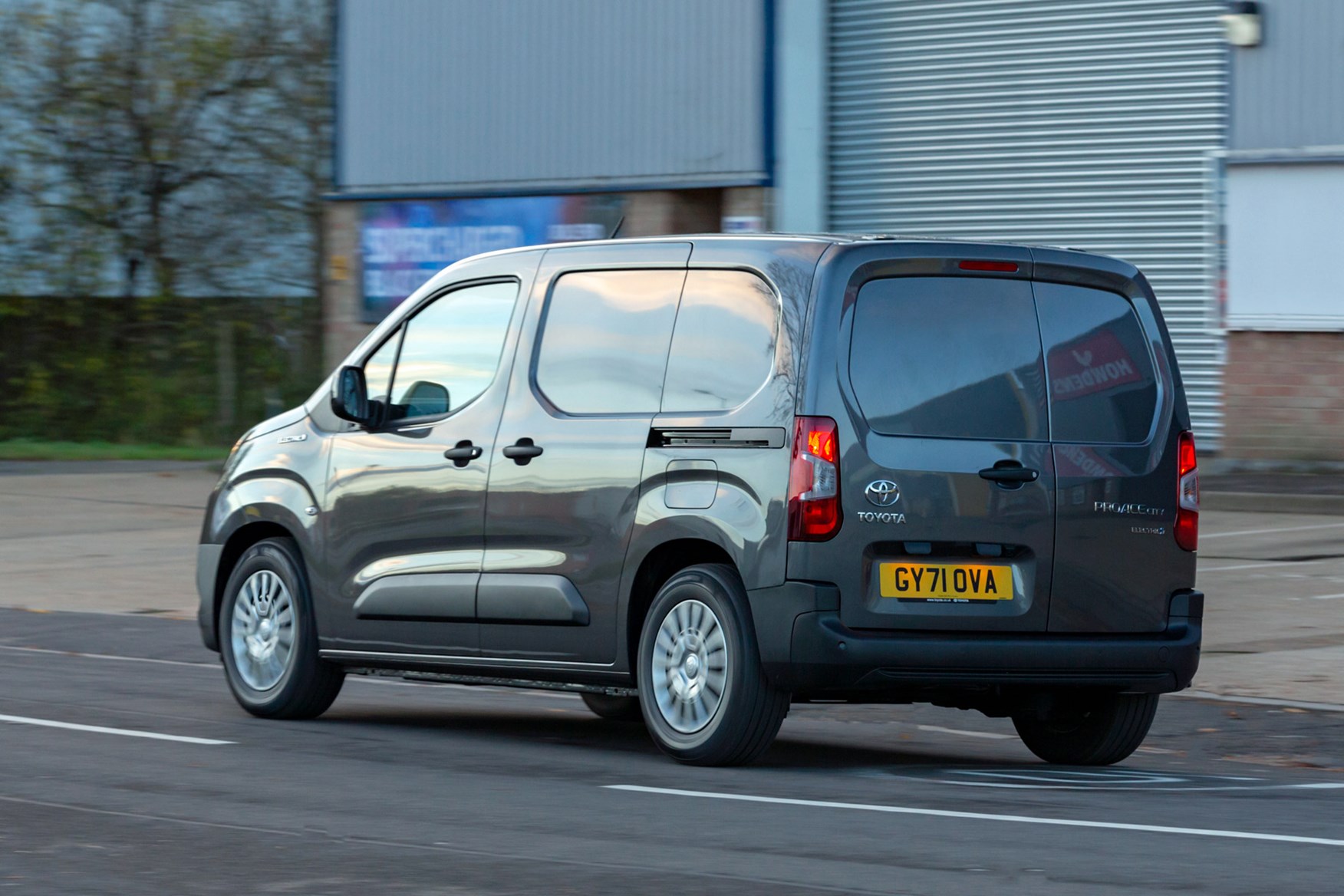
In full whack Power mode, the Proace City Electric will do 0-62mph in 11.2 seconds. It actually feels faster than this, thanks to the punchy immediacy of electric driving systems, and is quite good fun if you’re travelling empty along a country road. Really it’s designed for high payloads and towing, though, and you’ll see the driving range fall faster if you use this a lot.
Normal mode is perfectly adequate for most situations, and in fact we were quite happy pottering around in Eco most of the time in a lightly loaded van. Switching to Power is handy for overtaking, however, and pulling out onto tricky busy roundabouts.
Comfort and refinement
Even diesel versions of the Proace City are pretty quiet, so no surprises that the Electric version is practically serene, right up to motorway speeds, where there’s barely even a rustling of wind or road noise to worry about.
The suspension is equipped to handle up to 800kg of payload, so does get a little fidgety on bumpy surfaces without any weight in the back. But as small vans go, this is a pretty comfortable one, rarely severely upset by lumps or potholes.
The firmness in the suspension also makes it very deft around corners, with little body lean and light but direct steering.
Real-world driving range
Electric vehicles are more susceptible to driving conditions than other types of vans. So if you have a heavy right foot, are regularly fully loaded or simply mostly driving at motorway speeds, then you will find the Proace City Electric’s 168-mile claimed driving range to be somewhat optimistic. Cold weather can have a big impact on driving range, too.
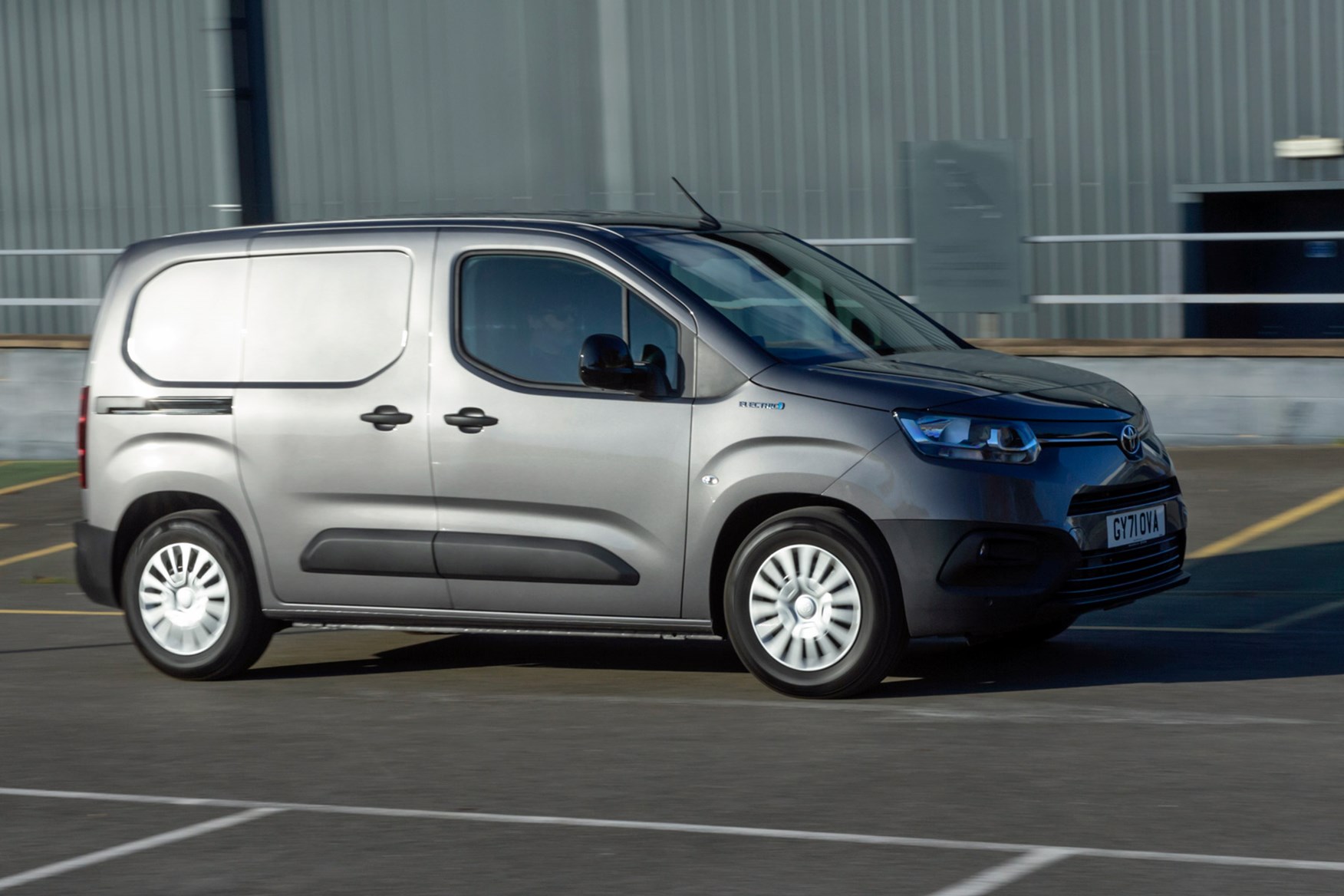
On the official test route at the launch of this van, we started with 162 miles of claimed range, drove 46 miles and ended with 95 miles of range remaining. This 16-mile discrepancy is pretty mild by electric van standards, and actually left us quite impressed – it was a mixed route covering all kinds of roads, and we drove using all three driving modes at different times.
However, we know from experience in the related Peugeot and Citroen vans that if you drive for extended periods at higher speeds – such as along a motorway between two towns – the driving range will plummet much, much more quickly.
Suitable for certain types of use only?
The upshot of this driving range issue is that these vans are best suited to people who can safely predict the kind of daily driving that they do.
Electric van technology works best at lower speeds, and especially in stop-start traffic around town, where the energy recovery system helps to gently recharge the batteries every time you brake or slow down (something that can be enhanced by using the B transmission mode, which more actively slows the van when you release the accelerator, increasing the amount of charge fed to the battery).
We’re confident that you will easily be able to travel over 100 miles in mixed driving in one of these before needing a recharge. But if you regularly go further than that you may be better sticking with a diesel van for now. Even ‘quick’ charging takes enough time to be problematic when you’re hurrying between jobs.
- Cab is similar to standard Proace City van
- Conventional steering wheel and instrument cluster
- Comfortable and spacious, but few fancy toys
The interior of the Proace City Electric is near-identical to convention petrol and diesel versions of this van – save for the lack of a traditional gearlever and some changes to the instruments to show information more important to electric vans.
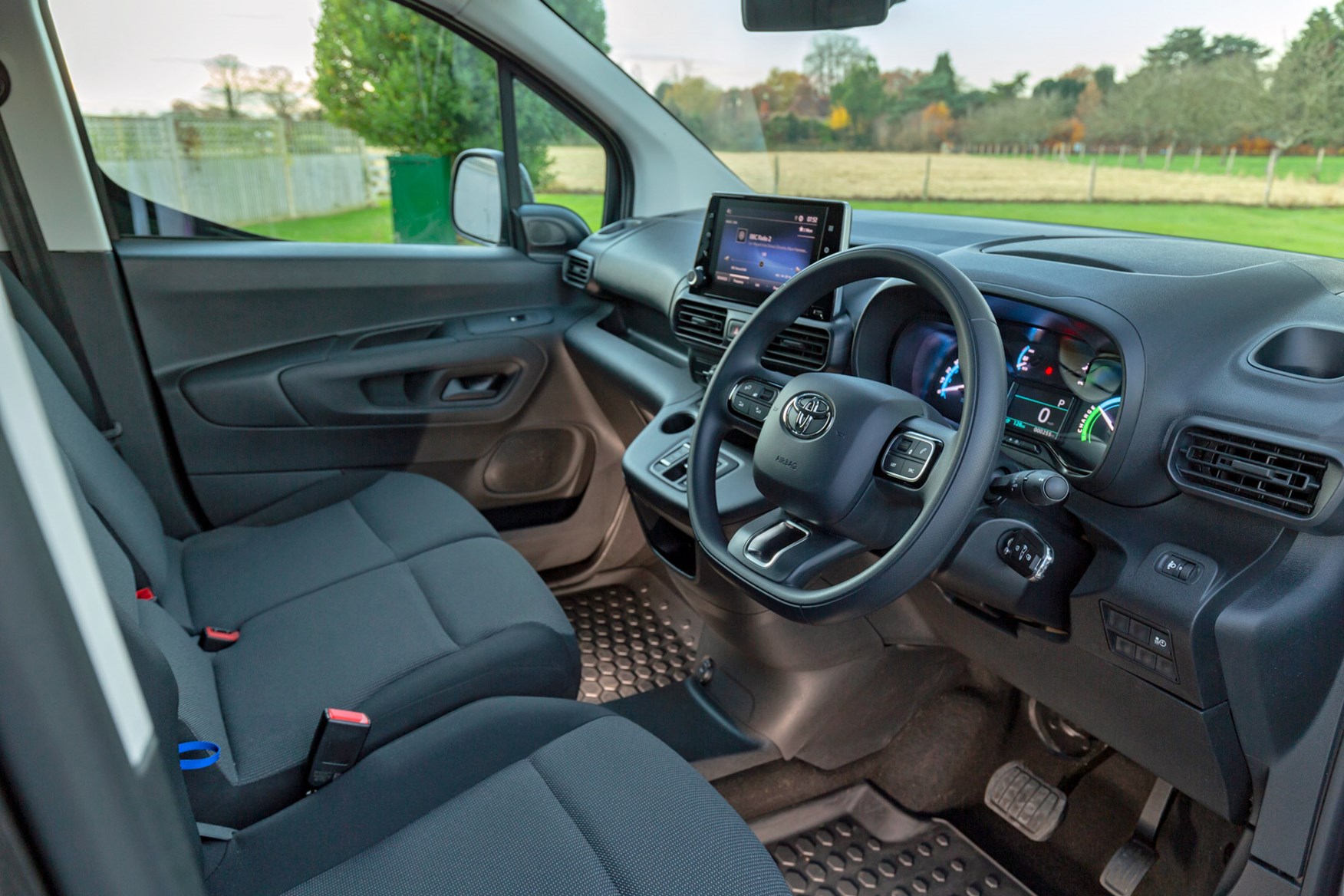
This is no bad thing, as these are relatively spacious, well-built small vans, with a good driving position and fine visibility. The ventilation controls can be difficult to see and use in the dark, but as your regular transport you’d get used to this.
Slightly more annoying is that replacing the gearlever with a switch hasn’t reduced the size of the protrusion from the centre console. It’s hardly surprising the manufacturer has shied away from fitting a substantially different dashboard, but it means that anyone crammed into the middle seat has no room for their knees.
Not anyone would want to be in the middle seat for long in one of these, regardless.
Not as fancy as the Stellantis versions
The rival Stellantis versions of this van are available with a digital instrument cluster and rear-view camera system, which Toyota has elected not to offer.
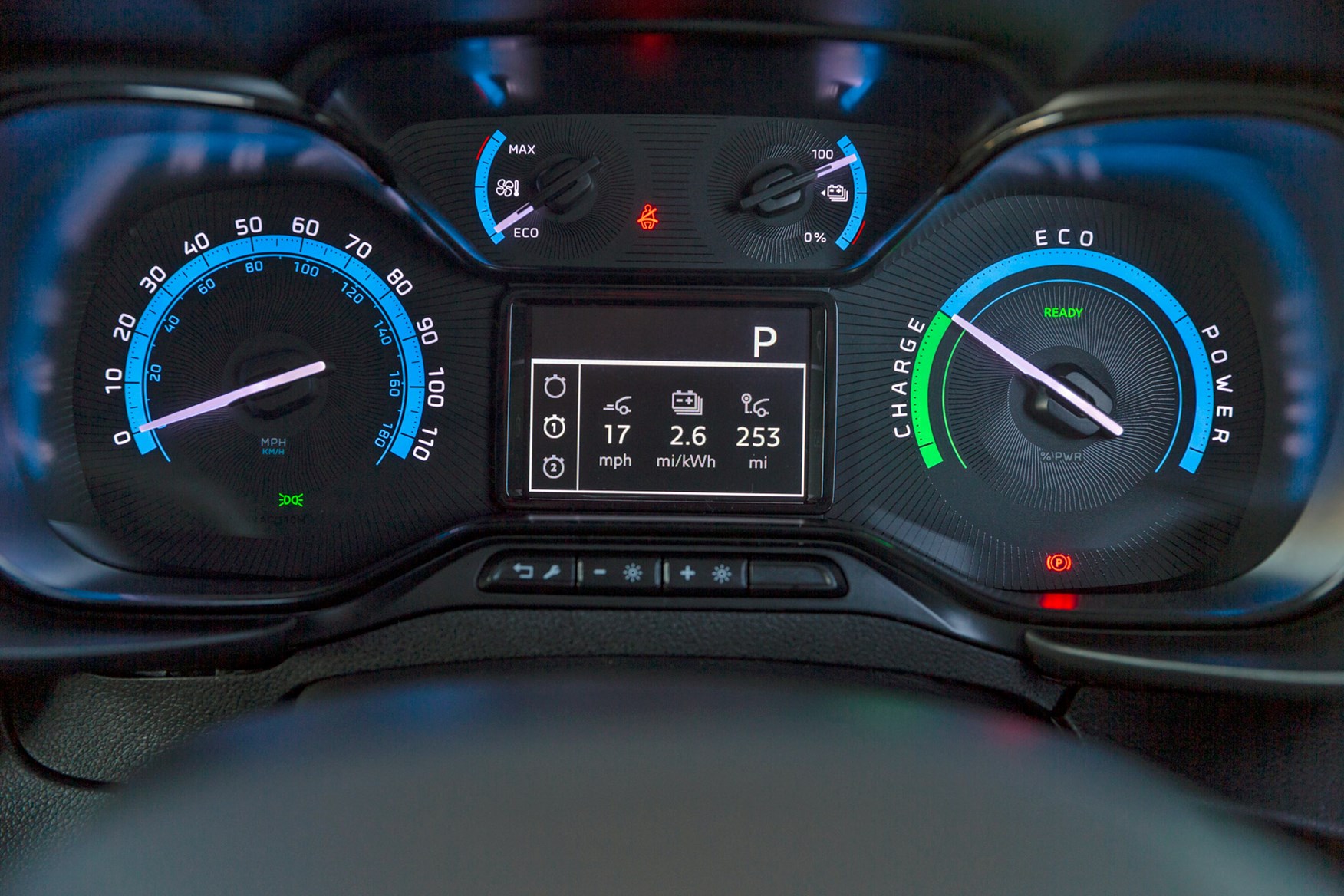
Frankly these are not something we missed at all – the standard instrument cluster is perfectly usable – but you know where to go if they are important.
- Pricey to buy but should be cheaper to run
- Up to 10 years of warranty coverage
- Standard equipment covers all the basics
With a basic price of just under £27,000 at launch – before VAT, on-the-road costs and the UK government Plug-In Van Grant – it’s obvious that buying even a small electric van outright isn’t a cheap business.
Monthly payments, however, are usually much more competitive, and despite the recent rise in energy costs, it should still be cheaper to run than most diesel vans. Especially when you consider the lower cost of servicing due to the reduced number of consumables such as engine oil.
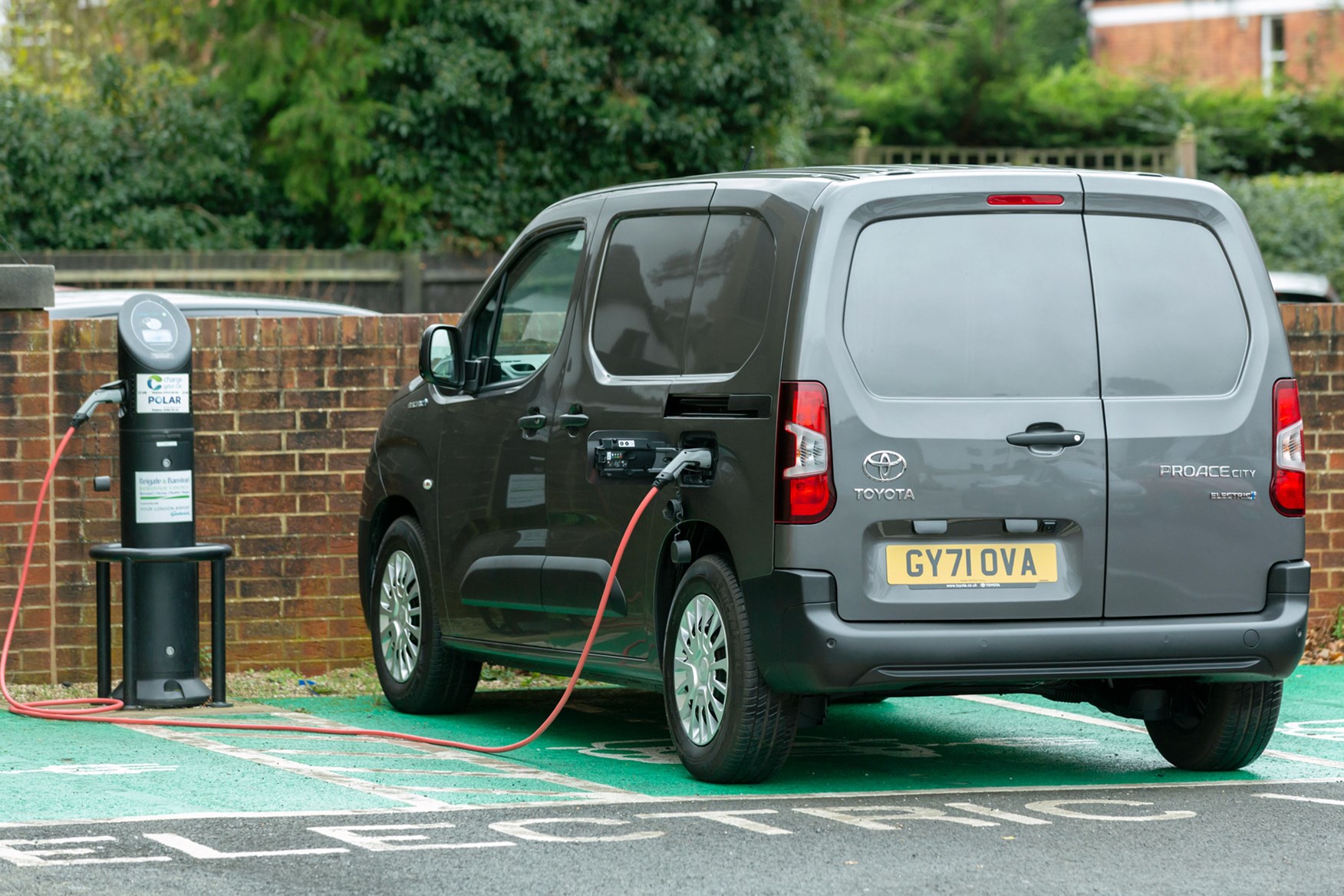
What’s more, Toyota Professional’s servicing promise for van owners includes a commitment that you will be able to get an appointment within seven days. If you can’t, labour costs are automatically reduced by 50%.
Toyota Proace City Electric service intervals
The standard service intervals for the Toyota Proace City Electric van are every 25,000 or two years, whichever comes sooner.
It should also receive an 'initial inspection' after the first year or 12,500 miles.
Toyota Proace City Electric warranty
The standard warranty is three years / 100,000 miles, whichever comes sooner.
The battery pack is covered for up to eight years / 100,000 miles.
However, the Toyota Relax warranty programme means that as long as the van is serviced by Toyota, warranty coverage is extended to up to 10 years at no extra charge.
>> Find out more about the Toyota Relax 10-year warranty for vans and pickups
Toyota Proace City Electric standard equipment
The Proace City Electric only comes in the Icon equipment grade, which is the higher of the two trim levels available for the standard Proace City van.
These are the standard equipment highlights:
- EV-specific instrument cluster with 3.5-inch multi-function display
- 8.0-inch touchscreen infotainment system with Bluetooth
- DAB radio, Apple CarPlay and Android Auto
- Reversing camera
- Two USB sockets
- Manual air-conditioning
- Rubber floor mats
- Adjustable speed limiter
- Smart cargo load-through bulkhead
- Six rear load hooks
- Lighting in the cargo area
For details of the safety equipment, see the Safety section.
While these are too new to show any issues at the time of writing, we also wouldn’t expect very many from an electric van – there are fewer moving parts than in convention internal combustion vehicles.
The basic van has also been in been in production for some time now, which should mean most other issues have been ironed out. The Stellantis factory that produces them doesn’t have the best track record for build quality, as evidence by a number of recalls for the standard vans, but Toyota is confident enough to cover its vans with up to 10 years of warranty, so you, the buyer, should be well protected from problems if they occur.
Standard safety equipment for the Proace City Electric includes:
- Electronic stability control
- Hill-start assist
- Downhill assist
- Tyre pressure monitors
- Six airbags
- Adjustable speed limiter
- Emergency eCall system
It appears that you can’t option the electric van with any of the more advanced safety features available on other versions of the Proace City.
Similarly, there’s no factory-fitted alarm, though you do get an immobiliser as standard.
Which Toyota Proace City Electric is best for me?
At the time of writing, the only choices available when selecting a Proace City Electric are the body length and the power-level of the on-board charger.
Whether you want a SWB or LWB Proace City will come down to what you need to carry in the back; the driving experience is otherwise similar. The smaller van has a slightly higher payload, the longer van offers more storage space.
Whether you need an 11kW on-board charger will depend on the power of the supply you have available. You need a three-phase supply for 11kW to work; most UK domestic power is single-phase, and limited to 7kW. Workplace power may be higher, however, so could be worth checking on if the vans are mostly going to be charged at the office or depot.



